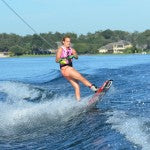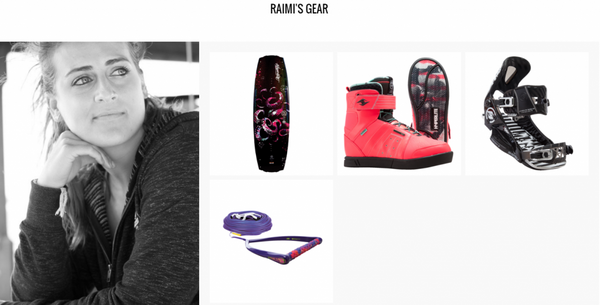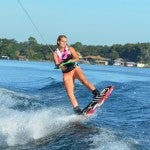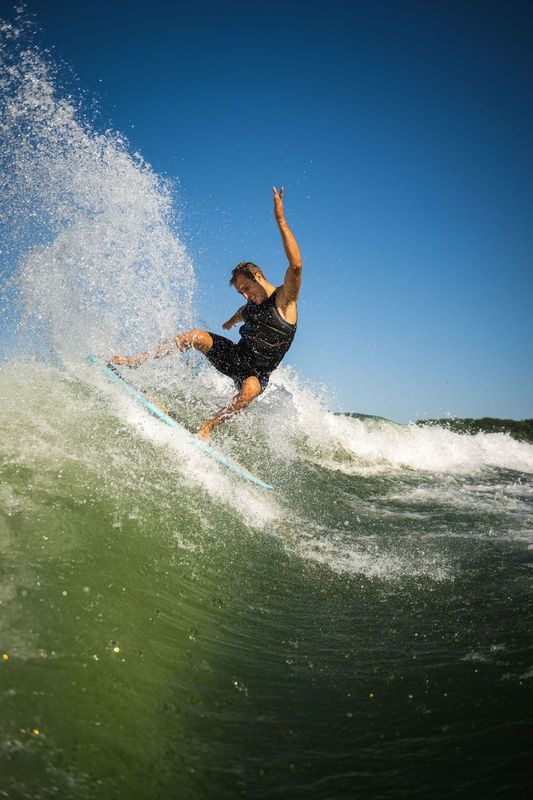Here's some good tips to start you off on how to wake board correctly!
Starting off - how to Wakeboard correctly.
Good basic techniques are at the core of better riding, for beginners and world champions alike. I work on them often. One key basic is riding the edges of the board.
 A wakeboard has two riding edges (where the bottom of the board meets the lengthwise sides). Once you begin to move side to side within the wake, and then outside the wakes, you will be riding one edge or the other depending upon whether you are moving to the right or the left.
A wakeboard has two riding edges (where the bottom of the board meets the lengthwise sides). Once you begin to move side to side within the wake, and then outside the wakes, you will be riding one edge or the other depending upon whether you are moving to the right or the left.
Because of the sideways stance of wake boarding, the lengthwise edge where your toes are nearest is the toe side edge, and the edge where your heels are nearest is your heel side edge. For right foot forward riding, you will be riding heel side edge when moving to the right, and toe side edge when moving to the left. It’s the opposite for left foot forward.
Start by carving inside the wake like a surfer. This drill will have you switching back and forth quickly from heel side to toe side. Do these same surf moves outside each side of the wake. Going from heel to toe side edge is done by keeping your upper body level and balanced while working your feet and legs by applying more pressure on either the front or back of your feet. Learn to control how much pressure you apply and develop an awareness of how each edge rides in the water. Then ride both edges on either side of the wake. See how far you can move away from the wake.
It’s essential to be balanced over your bindings, but the sideways stance means there are differences in body position. On the heel side you will have more leverage, because your toes and chest are facing the boat. It will be easier to hold the position as you edge. You will have to work harder to stay balanced over your bindings on the toe side. Your toes are facing away from the boat and this requires you to close your upper body from the boat and tuck your left arm (right foot forward riding) into your hip, which keeps equal pressure over the ball and toes of each foot. The heel side edge will feel more natural, but work both sides equally.
 Next, ride each edge away from the wake as far as possible. From this position, work your edging skills to maximize your wake jumps. The approach—how you turn in to the wakes—is critical for wake jumps. Since you have more leverage in the heel side, riders tend to turn in too hard. Aim for a slow, smooth turn and progressive edge, adding pressure as you ride toward and up the wake. The toe side turn will be slower, and that helps you turn the tip of the board to the wake. Make sure you start far enough from the wake that you have room to turn and point the tip of the board to the wake. Keep the edge progressive, with a closed upper body and arm tucked in, with pressure primarily on the forward portion of your feet.
Next, ride each edge away from the wake as far as possible. From this position, work your edging skills to maximize your wake jumps. The approach—how you turn in to the wakes—is critical for wake jumps. Since you have more leverage in the heel side, riders tend to turn in too hard. Aim for a slow, smooth turn and progressive edge, adding pressure as you ride toward and up the wake. The toe side turn will be slower, and that helps you turn the tip of the board to the wake. Make sure you start far enough from the wake that you have room to turn and point the tip of the board to the wake. Keep the edge progressive, with a closed upper body and arm tucked in, with pressure primarily on the forward portion of your feet.
With these drills you will learn the basics of edge control. And that will give you air time for awesome grabs, spins or inverts, and develop your riding style.
Equipment

Your board affects edge control. After 20 years of wake board design, all boards today do a good job with edge control. The more advanced boards, like my Hyperlite Maiden signature board feature a rocker design (curvature of the board from tip to tail) with a side cut and bottom design featuring tunnels and channels that work together to improve stability, tracking and direction of the board.
Bindings also contribute to edge control, since what you do through your feet and legs needs to be transmitted to your board. The bindings on the market, including open toe adjustable bindings do a great job of providing foot and ankle support. A more advanced closed toe binding like by Hyperlite Brighton provides even more foot and ankle support, provides great fit and comfort and connects me to my board very well.
Boards come with a center fin. Hyperlite offers four sizes that vary in depth (.8”, 1.0”, 1.3” and 1.5” for a varied ride from looser feeling to more directional with the deeper fin. Riders new to wakeboarding should start with a deeper fin for better tracking. Test your fins, and also try your board without the center fin, to see whether you like the feel of just riding the tunnel and channel features designed into the board.
About the Author…
 Raimi Merritt wins her 10th World Cup with her win in Linyi City, China. Raimi is also 2 times IWWF Open Women Wakeboard World Champion and a Masters Champion. Raimi is sponsored by Mynt, Nautique, Hyperlite, Rollei Actioncam America, Breathe Boardwear, Proof Eyewear, OrigAudio, Wakami, Peripheral LS and Fly High. Visit www.raimimerritt.com for the latest news.
Raimi Merritt wins her 10th World Cup with her win in Linyi City, China. Raimi is also 2 times IWWF Open Women Wakeboard World Champion and a Masters Champion. Raimi is sponsored by Mynt, Nautique, Hyperlite, Rollei Actioncam America, Breathe Boardwear, Proof Eyewear, OrigAudio, Wakami, Peripheral LS and Fly High. Visit www.raimimerritt.com for the latest news.
Raimi also offers personalized coaching in Orlando, Florida. E-mail
raimi@stevemerritt.com to schedule a lesson.


